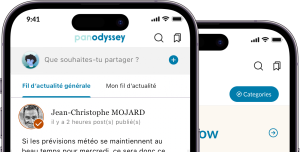
A Fresh Look at Internal Control in Insurance
 14 min
14 min
A Fresh Look at Internal Control in Insurance
The second line of internal control: an essential pillar in insurance. In the increasingly complex world of insurance, where risks and challenges intersect, internal control plays a crucial role. Think of yourself as an investigator, an advisor and a partner all rolled into one. This is where the techniques of observation, the detection of contradictions, universal propositions, the ability to stand back from situations and distance yourself from other lines of defence come into play. The second line, often overlooked, is nevertheless an essential pillar. It provides cutting-edge expertise, proactive assistance and rigorous monitoring. Its role? To guarantee that the rules, procedures and controls are complied with, while promoting the company's real capacity to assume them. But that's not all. The second line also coordinates the control activities of the first operational line. It works with the various specialised risk management bodies and the internal and external auditors. Together, they form a network of vigilance, reflection and continuous improvement.
In this article, we'll look at observation techniques, how to spot contradictions, how to find balance in your proposals, how to take a step back in your conclusions, and finally, the subtle art of keeping your distance from other lines of defence. If this sounds like your kind of adventure, follow the guide!
I. The sharp eye of the internal controller: The risk detective
Imagine yourself in the role of a detective, examining every clue, every detail, in search of the truth. In the complex world of insurance, the internal controller takes on this role with a crucial mission: to ensure that the rules are respected, while maintaining the company's real capacity to assume them.
Active observation: a superpower. During my testing sessions, I often came across descriptions of controls that were incomplete or too general. With a little practice, I can now spot these shortcomings effortlessly, thanks to this technique. I've also learnt to listen carefully1 (Sisto, 2022), which is a good complement to an objective view of a situation.
Playful learning. To sharpen your eyes, I recommend reading the book Visual Intelligence (Herman, 2020). This interesting and amusing journey will help you discover the most unexpected details, just like a real detective. After all, internal control is an ongoing investigation where every clue counts.
By adopting this approach, you'll become a keen detective in your field, able to spot risks where others only see the obvious. The ability to observe is important, but what do we do with our findings?
II. Spotting contradictions: The art of the detective
Imagine yourself in an old manor house, by candlelight, searching every nook and cranny for clues. In our discipline, we're all a bit like detectives. Spotting contradictions is our second secret superpower.
Hidden signs. Contradictions are often the symptom of an actual or potential problem situation. They are hidden in confusion, verbal statements and behaviour. Active observation, the magnifying glass of the internal controller, enables us to spot them.
Three types of contradiction.
1. Logical. Someone says, 'All the rules are bad'. This statement is itself a rule that must be considered invalid, creating an inconsistency. Looking for these inconsistencies is a valuable exercise. By practising formal logic (Brücher, Patrick et al., 2023), you can acquire some very useful automatisms.
2. Verbal and behavioural. Sometimes what is said does not correspond to what is shown visually. Discrepancies between what is said and how a person behaves are warning signals.
3. Inadequacies. When an attitude does not match a person's role or position in the organisation, there is a danger. These inconsistencies deserve our attention.
Managing contradictions. Caution is required. Managing these contradictions with empathy and emotional control is essential. Let's look for the causes in the environment.
Managing contradictions. Caution is required. Managing these contradictions with empathy and emotional control is essential. Let's look for the causes in the environment.
III. Universal proposals: Striking a balance
In the complex world of internal control, we juggle a multitude of stakeholders, interests and constraints. The more challenges we face, the greater the likelihood of inconsistencies. Imagine being on a tightrope, where every decision can tip the balance one way or the other.
The conflict of priorities. Let's take a concrete example: the latest regulations. The first line of defence will very quickly feel the need to optimise operational efficiency, which will come first, while the second line will focus on compliance. Favouring universal solutions2 wherever possible helps to manage divergent interests.
Dilemmas. When these arise, dialogue is our ally. Here are some steps to orient yourself in the fog:
1. Know the constraints: they are inescapable. You won't have a choice.
2. Manage the stakeholders: Identify them all, even those in the shadows. Meet them, understand their specific context, their concerns and their obstacles.
3. Evaluate the options: examine them from every angle. Focus on the essential minimum and avoid overdoing things or making unnecessary demands.
4. Talk to your colleagues, your manager: they can be your mentors.
5. Make informed decisions: consider all interests.
6. Defend your choice: be prepared to explain your decision.
7. Give clear instructions: they are a precious help in complicated situations. Take care with them. They should be clear, simple, precise and unambiguous(Gerard et al., 2009, p. 274‑278).
Walking this tightrope, we try to satisfy, guide and support all stakeholders. Now let's see what the right measure is in our activities.
IV. Stepping back: Gaining perspective
Every situation in our business is unique and multifactorial. Sometimes common patterns emerge, but knee-jerk reactions can be misleading. Our brains automate repetitive tasks related to our perceptions, learning and problem solving (« Peut-on se prémunir contre nos biais cognitifs? », 2023). Hindsight then becomes crucial when it comes to objectively deciding the content of our conclusions or the course of action to take in a given situation.
Be critical. When you are preparing your proposals for a meeting, writing reports or instructions, look at them through the eyes of the people you are dealing with. Look for potential problems or inconsistencies.
Assess the impact. Consider the impact on stakeholders and the organisation. Every decision has consequences, so anticipating them is essential.
Manage the capacity for change. Assess your stakeholders' perceptions of your proposals. Avoid overstepping their boundaries in accepting change, but be prepared to lead them to better practices or different ways of thinking.
Review your position. Finally, if necessary, reconsider your position. Stepping back allows you to broaden your perspective and support informed decisions.
By stepping back, you'll be better equipped to navigate the complexities of internal control. But what is the subtle difference between stepping back and standing back?
V. Distancing yourself: A delicate balance
In the area of internal control, distancing yourself is a subtle art. Think of yourself as a tightrope walker, balancing objectivity, support an independence. This section explores this delicate challenge.
The complex equation. The first line, responsible for resolving the improvement points identified by the second, often navigates in murky waters. I have experienced this myself as a tester on the second line. When a problem involves several multidisciplinary teams, the desire to intervene and help is strong. But sometimes the best thing to do is not to.
Careful observation. I've opted for careful observation. This emotional distance gave me reasonable assurance that the task was progressing at its own pace. The result? The working group not only resolved the initial difficulty, but also made other highly relevant improvements. The progress made in terms of collaboration and mutual ownership was palpable.
Partner and spectator. Supporting also means knowing how to take a step back. Implementing recommendations must be about reducing risk, not just closing a loophole. A second line of control intervening at this crucial moment could introduce a bias or disempowerment into the resolution of the problem, which is anything but desirable.
An unstable balance. By staying out of the situation being assessed, while observing closely, a balance is maintained that encourages ownership of activities, while the second line keeps a watchful eye without being intrusive.
Independent partner. More generally, an appropriate distance also allows you to maintain your independence in a collaborative environment with the other lines of defence.
VI. Case Study
Here is a fictitious case where the concepts discussed in this article come into play.
Scenario: Interview with a risk manager
Context: You are conducting an interview with a risk manager in the insurance company. Your objective is to assess the risk coverage provided by existing controls.
Approach: During the interview you use active observation techniques:
• You pay close attention to the manager's body language.
• You note the moments when he hesitates or avoids certain topics.
• You ask open-ended questions to probe further.
Observations: When discussing a specific risk related to insurance claims, you notice that the risk manager clenches his fists and looks away. He looks uncomfortable.
Analysis: Combining your visual observation with your knowledge of risk, you suspect that this particular area merits further interest on your part. You decide to dig deeper and check the controls in place. Careful examination of the evidence provided allows you to identify an insignificant detail in isolation, but which you recontextualise in relation to the manager's discomfort that makes the situation worrying.
Additional questions: To clarify the manager's unease during the initial interview and your questions about the controls, reassure your interviewee about the confidentiality of the controls.
Listen carefully: You note the contradictory statements made by the manager. For example, the manager may say that the controls are effective, but mention his concern about the problems of incomplete descriptions, which is a contradiction.
Respond with empathy: When the manager expresses concerns, show that you understand and take their comments seriously. Avoid any judgement or personal criticism.
Ask targeted questions: ask questions to clarify. For example:
-
“Can you elaborate on your view of the effectiveness of controls?”
-
“How do you reconcile this concern with your overall assessment?”
Contextual analysis: You find that the explanations for one of the controls is the result of a misunderstanding due to stress on the part of the manager, without increasing the risks associated with that control. You note this in your report.
Result: Using this approach, you identify gaps in the controls. After taking the necessary distance and identifying the impact on the manager and the organisation, you recommend specific but measured improvements to strengthen risk coverage in this area.
VII. Conclusion: To infinity and beyond
In this article we have explored the mysteries of internal control like a detective looking for clues in an old mansion. We have sharpened our eyes, juggled with contradictions, come up with reasonable universal propositions, taken a step back from our work and exercised a healthy distance from other lines of defence. But that's just the beginning.
Internal control takes us on a never-ending journey where every detail counts. The rules change, the players multiply and dilemmas arise. So let's keep our magnifying glasses at the ready, our neurons alert, and continue to explore the twists and turns of this never-ending quest.
And who knows? Maybe, just around the bend in a dark corridor, we'll find the key that opens the door to new horizons. To infinity and beyond!
Notes
1 Active listening is a valuable skill that enhances emotional understanding, strengthens interpersonal relationships, promotes conflict resolution and develops empathy. It has a positive impact in the workplace and contributes to personal growth.
2 Solutions that benefit all parties involved without taking sides or favouring any specific group.
References
Brücher, Patrick, Scheer, Kris, Vilm, Jérôme, & Weis, Bernard. (2023, décembre 1). Logique Formelle – Module d’introduction. https://philosophia.lu/downloads/dossier_logique_propositions_finale.pdf
Gerard, F.-M., Roegiers, X., Bosman, C., Hoyos, G., Huget, G., & Georgette, Y. (2009). Des manuels scolaires pour apprendre : Concevoir, évaluer, utiliser (2e. éd). De Boeck.
Herman, A. E. (2020). Visual intelligence : Sharpen your perception, change your life. Harper One.
Peut-on se prémunir contre nos biais cognitifs ? (2023). Dossiers Cairn, 8, 1‑1.
Sisto, L. de. (2022). Écoute active : Comment vraiment entendre les gens, apprendre des techniques de communication efficaces, améliorer tes relations et tes aptitudes à la conversation. Books on Demand.
Credits
Illustrations: Made with Copilot









 English
English
 Français
Français
 Deutsch
Deutsch
 Italiano
Italiano
 Español
Español



 Contribuer
Contribuer








 Tu peux soutenir les auteurs qui te tiennent à coeur
Tu peux soutenir les auteurs qui te tiennent à coeur





